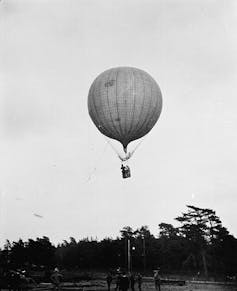News
Both sides in the Russia-Ukraine war are using new and old technologies for warfare

On the other hand, this new technology has played a major part in forcing infantry to dig lines of trenches reminiscent of the First and Second World Wars. (Pixabay photo)
When it comes to technology, the war in Ukraine is a war of juxtapositions. On the one hand, this is the first major war in which a variety of unmanned aerial vehicles (UAVs) — or drones — have played such a prominent role. On the other hand, this new technology has played a major part in forcing infantry to dig lines of trenches reminiscent of the First and Second World Wars.
Some of the technology in the war in Ukraine, such as the guided missiles being used by both sides, isn’t fundamentally all that new. Modern guided missiles trace their origin back to early developments during the latter part of the Second World War.
Modern precision-guided weapons may be increasingly accurate in hitting their targets, but there is all too often considerable human error in allocating targets for them.
What is new in the war in Ukraine is that it isn’t like many of the “small wars” of the late 20th and early 21st centuries, in which one side had an almost overwhelming technological advantage. The Taliban in Afghanistan didn’t have access to satellite imaging, large drones and precision-guided munitions, or even weapons to counter these, so they had to fight an “unconventional” or “asymmetrical” war.
In the war in Ukraine, both sides have access to and are developing new and not-so-new technologies, with neither side having an overall technological edge.
Drones and warfare
Large drones have been in use in war for a number of years now. The United States in particular made heavy use of large drones such as the Reaper in Afghanistan, both for reconnaissance and targeted killings. Russia made use of large drones for reconnaissance in Syria when its forces were supporting the Assad government there.
What is different in the war in Ukraine is the sheer number and range of drones being used. Large drones are still being used — including Iranian-developed “suicide” or “kamikaze” drones like the Shahed being used by Russia — that can strike targets deep inside enemy territory. However, smaller drones are being used by both sides — often nearer to the frontline — for reconnaissance, artillery spotting and as kamikaze drones.
At the beginning of the war, the Ukrainian side had an advantage in drone warfare — that advantage has now arguably passed to Russia. Russia has been able to produce and import huge numbers of drones and develop some effective local countermeasures against Ukrainian drones.
Ukrainian naval drones have, however, been a particular problem for the Russian navy.
The recent sinking of the large patrol ship Sergei Kotov with naval drones is a case in point. Modern warships are not bristling with the sort of anti-aircraft guns that their Second World War counterparts had to stop kamikaze pilots for example.
But quite possibly they will soon be bristling again, because such guns are ideal for dealing with drones at close range. Even the humble torpedo net from the late 19th century may make a return to try to stop drones reaching ships at anchor.
Missile technology
While in Iraq and Afghanistan, the U.S. and other western powers made heavy use of guided missiles. What is different in Ukraine is that both sides have access to them.
For example, the Russian Iskander and Anglo-French Storm Shadow missiles have proven highly effective at striking targets deep in the enemy rear. Often targets for such missiles have been located using drones.
Many tanks are being destroyed not only by or with the help of drones, but with anti-tank missiles such as the Russian Kornet, or much vaunted U.S.-supplied Javelin on the Ukrainian side.
Anti-tank missiles are not new — the Egyptian armed forces for example made good use of recently developed Soviet anti-tank missiles during the Yom Kippur War in 1973.
The anti-tank missiles being used in Ukraine today are however much more sophisticated. Back in 1973, anti-tank missiles often had to be connected to the operator through a fine wire that was reeled out by the missile as it flew! Today’s missiles typically have more sophisticated and reliable targeting.

(Dan Hadani Collection, The Pritzker Family National Photography Collection, The National Library of Israel), CC BY
New and old technologies
A lot of drone use is for reconnaissance to help both sides carry out much lower technology tasks, such as targeting conventional artillery or guiding infantry.
While new technology has transformed the fighting in Ukraine, there are still many elements that would be easily understood by soldiers in the First World War.
Firstly, regardless of all the technology, ultimately the “poor bloody infantry” has to move in and occupy territory — and fight for it at close quarters. Soldiers still often have to kill other soldiers while in close proximity to each other.

(Imperial War Museum)
Typically, the technology of today may be new, but the function isn’t. We could, for example, see drones playing a role like the observation balloons of the First World War. These were used in particular for directing artillery fire.
Balloons stopped being used in war because of the development of weapons that could easily shoot them down, from aircraft to high-powered anti-aircraft guns.
When a new technology comes along, the race begins to counter it. The Russian armed forces have already had some success in jamming the link between drone operators and their drones.
In the constant technological battle, what is next? Autonomous drones using AI are in many ways a nightmare idea, but they are being worked on. Autonomous anti-drone drones would no doubt follow.
One thing is certain — new technologies will be developed, to be followed by countermeasures. New hi-tech ways of killing or facilitating it will continue to serve alongside the old methods.![]()
Alexander Hill, Professor of Military History, University of Calgary
This article is republished from The Conversation under a Creative Commons license. Read the original article.





















